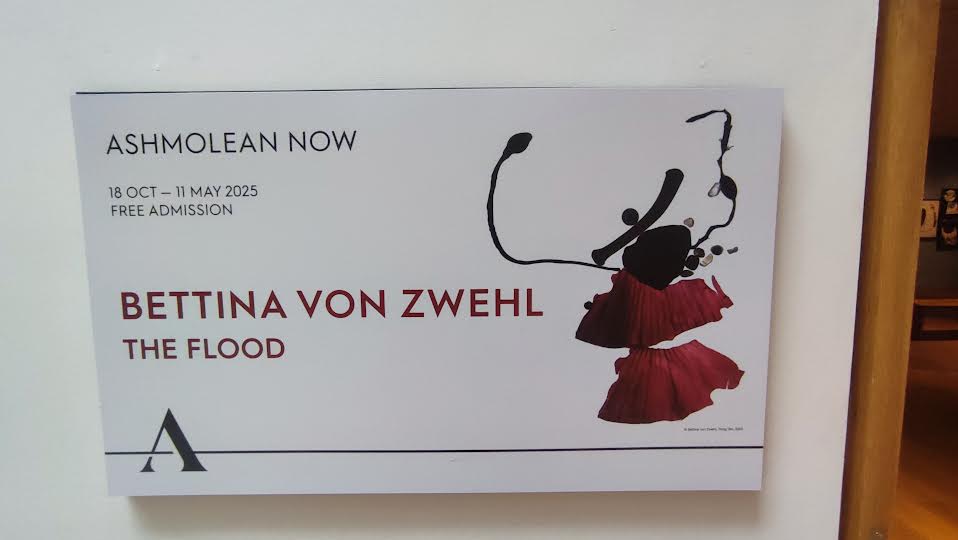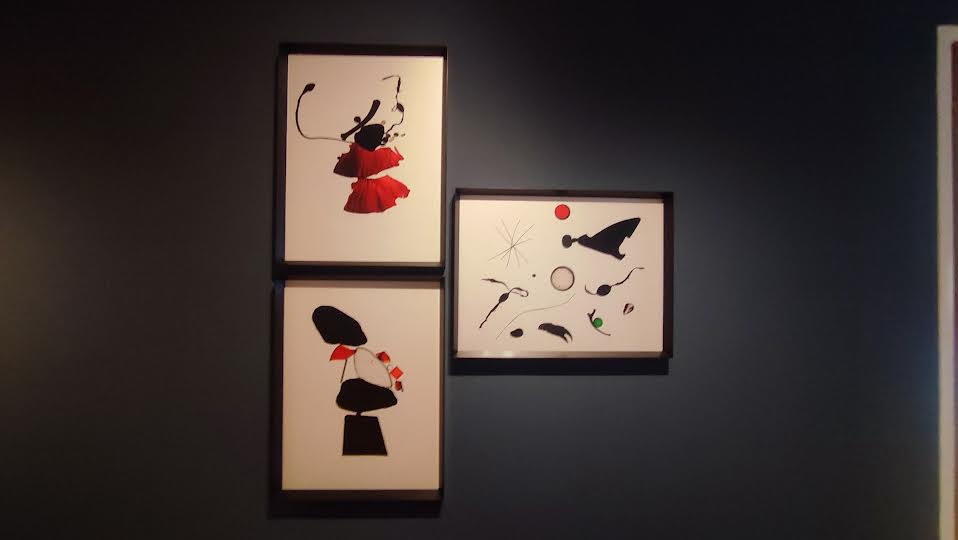The Ashmolean - Ashmolean NOW: Bettina von Zwehl: The Flood - Review
★ ★ ☆ ☆ ☆
The train down to Oxford was atypically pleasant. I'd set
off early, leaving Manchester at 07:25, and watched the muted sunrise usher in
the day as we trundled down south. Arriving in Oxford, the weather still
bitingly cold, I walked east - stopping by Gloucester Green to pick up a few
pairs of earrings from the market - towards the Ashmolean.
I'd come south this particular day for my dad's birthday and
thought to double up the visit with, yet another, explore of Oxford's museums
and galleries. Today, The Ashmolean were opening their new exhibition on Anselm
Kiefer, but - in a typically frugal fashion - I chose to go instead to their
free temporary exhibition.
After making my way to the basement floor - not the most auspicious
location for a temporary exhibition - I became once again distracted by the
spectacle of the museum. You see, this floor contains the bulk of the
performative introspection for the Ashmolean. An exhibition on the history of
the institution. One on the role of a conservator. The shuffled aside Textiles
Gallery, and the inevitable Cafe. There is an article to be written here on the
relegation of subjects literally to the basement - parallels with the placement
of the Benin Bronzes in the British Museum. Kletchka has a good article of the
physical location of many arts educators offices and teaching spaces within the
basement of museums and galleries, and the Ashmolean is not an exception to
this rule.
All this is to say that I came to Bettina von Zwehl's 'The
Flood' with the expectation that it may offer a challenge to the museum, its
placement in the basement being a product of an under analysed institutional
shame, perhaps. This was not the case.
The triple titled exhibition is the third in a series in
which artists are invited to create works inspired by the Ashmolean's
collections. London-based photographer, von Zwehl, was in residency between
2022-3, and, using items found in collections across GLAM, has created original
artworks. Disclaimer text appears underneath the poster outside the exhibition
informing the visitor that "this exhibition contains natural history
objects and images" that explore and interrogate the past. A catalogue
(£20) is advertised.
So, artist in residence using the collections to produce
artworks - I'm expecting a praxiological intervention into the idea of museum
space and collecting. What I find within, however, is a non-critical but
aesthetically impressive reconstruction of ideas of wonder and amazement.
Beautiful but toothless. Perhaps my fault for expecting teeth.
von Zwehl frames her work around the idea of the
'Wunderkammer' or cabinet of curiosities. An enlightenment phenomenon
constructed by affluent collectors that combines items - often natural history
or geological - considered oddities or marvels. Strange things still not folded
into the protean modern project, not yet constrained by a fully developed
system of taxonomy. A 17th century step towards our current understanding of
the museum. And, in the right hands, an interesting entry-point for critique of
the museum.
A video plays at the entrance, a conversation with curator
Lena Fritsch. It outlines von Zwehl's approach, both in subject and in
practice. We learn that the majority of artworks are created by sampling
interesting things from the archives, placing them on a glass pane and shining
light underneath them, to create beautiful silhouettes which are then
photographed. A printed quote on the wall illuminates the reasoning behind the
title of the exhibition. The Flood invokes an idea of chaos, a jumbling-up of
sorts, a breakdown of contemporary taxonomies of collecting. What we see in the
gallery is life after the flood.
We are told the works "aim to rekindle wonder and
curiosity as critical tools for generating new ideas while reflecting on our interdependent
relationships with minerals, plants, fungi, and other non-human domains of existence."
This - to me - is both a valid reason to construct this exhibition
and is successful. Artworks combine different materials: organic and
non-organic. Wonder and curiosity are invoked. Yet, wonder and curiosity are
not - for me - enough. The purpose of this gallery is lacking in any sense of
institutional critique, or even a willingness to question why objects were
collected and ordered in such ways to begin with. There is both a vacuum of
interrogation around the Wunderkammer and a similar vacuum around contemporary
collecting and cataloguing practices. Ultimately, it feels as if the gallery says,
'what if we all shuffled everything around a bit', without ever sinking its
teeth into the meat of the museum or the gallery. It’s as if a fish becomes
suddenly very interested in the colour and shape of the rocks below it, without
ever realising that it is in a tank.
Back to the exhibition at hand, we see a striking image of a
preserved monkey. Is this curiosity morbid? Later on the inclusion of a
preserved aye-aye cements the Wunderkammer aspect of the space. Only, curiosity
here is more akin to Ripley's believe it or not. The morbid fascination aspect
is valid in that it forces the viewer to consider the reason for their viewing
of these objects, alongside the more standard rocks and insects. Yet, to what
extent this critical viewership is suggested or made possible by the
exhibition, I couldn't tell.
The stars of the exhibition are the silhouette photographs.
Each of them plays like a Miro or a Vezelay. Almost musical compositions of
lines and forms dancing within their frames. I love this kind of work, and the
choice use of colour is very effective.
Only, once you realise that each shape is a 'thing', the
experience of viewing metamorphoses into a much simpler puzzle or game. Rather
than contemplating images in their entirety, I begin to see the shell of a
beetle, a casted mould of some teeth, a thread of fabric. They look like
microscope slides unpicking and illuminating cell structures. There is
something to be said for the work's success in continuing the theme of the
flood and the chaotic re-ordering of life afterwards. We begin to see a plateau
of natural connections in which lines branch out rhisomatically between each
node. [here I have deleted a self-indulgent recapitulation of Deleuze and
Guattari's Thousand Plateaus].
In all honesty, I would have preferred the works if they
were not a puzzle of wonderous objects, but merely the work in and of
itself.
Their placement - effectively into triptychs - was a nice use of space. The entire room, in fact, is pleasantly laid out, with calm lighting and a sub-marine colour palette. However, the centre of the room is dominated by a large table upon which fungi are lazily glued to small boards. They are almost drowning in glue. Perhaps they are to speak to ideas of the perpetuity, inevitability or eternality of fungal life. I wasn't taken by them.
Also not to my liking was the inclusion of a model theatre,
in which a glass orb can be used to view the inverse of an upside-down image of
a woman. Any thoughts inspired by this piece - of age, performativity, decay,
isolation, illusion - didn't fit within the wider gallery. I imagine its
inclusion here was purposeful and that von Zwehl could give me a convincing
argument for why it was here. Yet, without much more to go on, it felt - to me
- out of place.
At the far end of the exhibition is a Wunderkammer. Here we
find the aye-aye, alongside lots of curios. Rocks with eyelashes. Photographs
of children, snakes draped around their necks. In a more declarative critical
context, it would be a provocative act of curation. The presence of forgeries
and ideas of authenticity, strange connections and the resurgence of morbidity.
It all works. Only, here, it feels like a flat addendum. A punchline to a joke
that hasn't been built up.
Neighbouring this is perhaps the most interesting object found within the gallery. A small book. It is displayed open to a page upon which is written an outmoded taxonomy of collecting - a view of the whole. Yet, as an object, it is denied context - it has no label, presented as art rather than historical anchor point. I ultimately find its name, date and author from a large print booklet stowed within the exhibition. The Musaeum Tradescantianum; or, A Collection of Rarities by John Tradescant, from 1656. Here it is, and here is the entryway into a discussion of collecting and curiosity that has been neglected by the exhibition as a whole. Here, it is merely an appendix.
Overall, von Zwehl's work, her photography, is remarkable. The images are beautiful and engrossing. Some of the ideas within the space are strong. However, it misses such an obvious angle of criticality, that it is ultimately a disappointing - if pleasant - space. Perhaps were I to have visited this in a gallery setting, outside of the Ashmolean, I may have found it more understandable. But the lack of praxiological critique in favour for a toothless engagement in wonder and curiosity felt like a real missed opportunity.
Ashmolean NOW: Bettina von Zwehl: The Flood is on at the
Ashmolean between 18 Oct - 11 May and is free to enter.
★ ★ ☆ ☆ ☆












Comments
Post a Comment